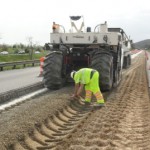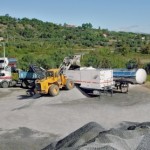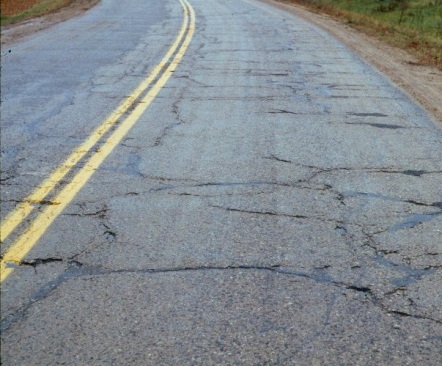 Pavement Recycling is a technique where an existing degraded pavement is modified and transformed into a homogeneous structure that can support the traffic requirements. Materials from the existing pavement are reused in the construction of a new layer and can result in considerable savings of material, money, and energy. Because of the reuse of existing material, pavement geometrics and thickness can also be maintained during construction. In some cases, traffic disruption is less than that for other rehabilitation techniques. Pavement recycling is used for a number of applications, from heavy trafficked highways to low volume roads. Airport pavements have also been constructed with recycled pavement materials.
Pavement Recycling is a technique where an existing degraded pavement is modified and transformed into a homogeneous structure that can support the traffic requirements. Materials from the existing pavement are reused in the construction of a new layer and can result in considerable savings of material, money, and energy. Because of the reuse of existing material, pavement geometrics and thickness can also be maintained during construction. In some cases, traffic disruption is less than that for other rehabilitation techniques. Pavement recycling is used for a number of applications, from heavy trafficked highways to low volume roads. Airport pavements have also been constructed with recycled pavement materials.
Recycling is only one of the several rehabilitation alternatives available for asphalt pavements; other common methods are thick or thin hot mix asphalt (HMA) overlay. The choice of rehabilitation alternative depends on type and severity of pavement distress, laboratory and field evaluation of existing material, and design parameters. Maintenance of geometrics and original thickness of pavements, especially in underpasses, can also influence the choice of rehabilitation method. However, recycling has some unique advantages, can result in savings, maintain pavement geometrics and thickness, and help conserve natural resources. Different recycling methods are now available to address specific pavement distress and structural needs.
Recycling Methods and Processes
The four primary methodologies in pavement recycling are:
- Hot recycling (HMA and WMA containing Recycled Asphalt Pavement (RAP)
- Hot In-place Recycling (HIR)
- Cold Recycling, either Cold In-place Recycling (CIR) or Cold Central Plant Recycling (CCPR)
- Full Depth Reclamation (FDR)
Hot Mix Asphalt (HMA) and Warm 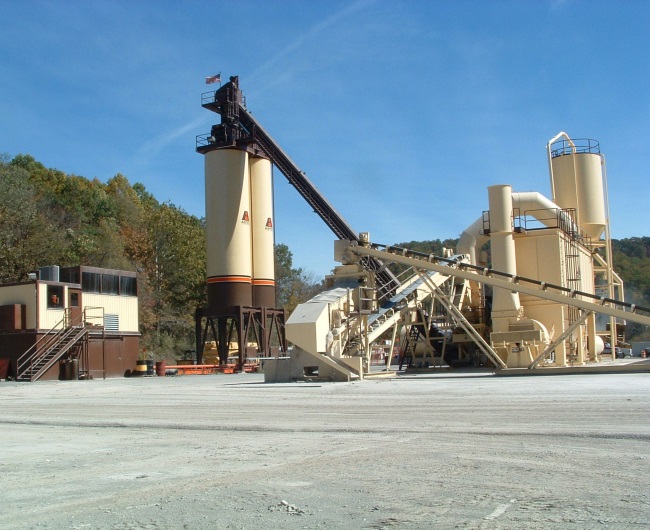 Mix Asphalt (WMA) recycling is the process in which Reclaimed Asphalt Pavement (RAP) is combined with new materials to produce HMA/WMA mixes. Both batch and drum HMA/WMA plants are used to produce RAP mixes. The RAP material can be obtained by milling or a crushing operation. The mix placement and compaction equipment and procedures are the same as for regular HMA/WMA. RAP percentages range from 10 to 50 percent. The advantages of hot mix recycling include equal or better performance compared to conventional HMA/WMA, and capability to correct most surface defects, deformation, and cracking. RAP use is covered in more detail under the RAP Technical Brief.
Mix Asphalt (WMA) recycling is the process in which Reclaimed Asphalt Pavement (RAP) is combined with new materials to produce HMA/WMA mixes. Both batch and drum HMA/WMA plants are used to produce RAP mixes. The RAP material can be obtained by milling or a crushing operation. The mix placement and compaction equipment and procedures are the same as for regular HMA/WMA. RAP percentages range from 10 to 50 percent. The advantages of hot mix recycling include equal or better performance compared to conventional HMA/WMA, and capability to correct most surface defects, deformation, and cracking. RAP use is covered in more detail under the RAP Technical Brief.
Hot in-place recycling (HIR) is a method in where the existing pavement is heated and softened, and then scarified/milled to a specified depth. New HMA/WMA (with or without RAP) and/or recycling agent may be added to the scarified RAP material during the recycling process. HIR can be performed either as a single pass or as a multiple pass operation. In single pass operation, the scarified in-place material can be combined with new material if needed or desired. In multiple pass operation, the restored RAP material is recompacted first, and a new wearing surface is applied later. The depth of treatment varies between 20 to 50 mm (¾ to 2 in). There are three HIR processes;
where the existing pavement is heated and softened, and then scarified/milled to a specified depth. New HMA/WMA (with or without RAP) and/or recycling agent may be added to the scarified RAP material during the recycling process. HIR can be performed either as a single pass or as a multiple pass operation. In single pass operation, the scarified in-place material can be combined with new material if needed or desired. In multiple pass operation, the restored RAP material is recompacted first, and a new wearing surface is applied later. The depth of treatment varies between 20 to 50 mm (¾ to 2 in). There are three HIR processes;
- Surface recycling – Existing asphalt surface is heated and scarified to a specified depth; the scarified material is combined with aggregate and/or recycling agent and recompacted. A new overlay or treatment is placed in the recycled mix.
- Repaving – A simultaneous combination of surface recycling with an HMA/WMA overlay placed and compacted at the same time.
- Remixing – Scarified RAP is combined with virgin HMA and mixed in a pugmill then placed and compacted as a single mix/lift.
Cold Recycling – There are two types or categories of cold recycling where manipulation of the existing pavement material occurs without the application of heat. (CIR); and one where the existing pavement material is removed and carried to a central processing plant for manipulation without the application of heat (CCPR). The CCPR material is then brought back to the site where it is placed and compacted.
- Cold In-place Recycling (CIR) is where
 the existing pavement is pulverized/manipulated in-place and recompacted into a pavement layer. No transportation of materials is usually required (except for any recycling agent or binder) and aggregate can be added. Normally, either a foamed asphalt binder or an asphalt emulsion is added as a recycling agent or binder and proportioned as a percentage by weight of the RAP. Portland cement, fly ash or quicklime is sometimes added to improve mix stability.
the existing pavement is pulverized/manipulated in-place and recompacted into a pavement layer. No transportation of materials is usually required (except for any recycling agent or binder) and aggregate can be added. Normally, either a foamed asphalt binder or an asphalt emulsion is added as a recycling agent or binder and proportioned as a percentage by weight of the RAP. Portland cement, fly ash or quicklime is sometimes added to improve mix stability. - Cold Central Plant Recycling (CCPR) is similar to both a traditional asphalt plant and a CIR process. With CCPR, material removed from an existing asphalt pavement is transported to a central location – either
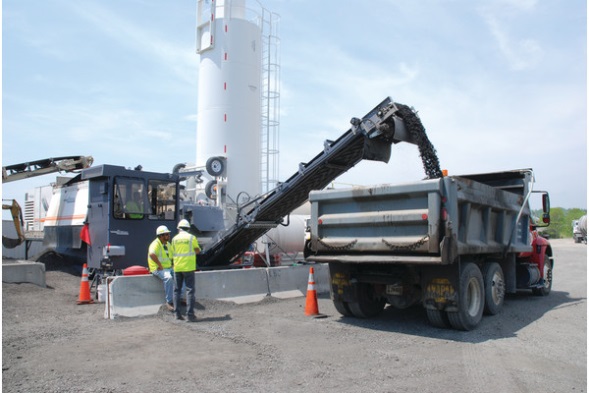 on the project site or an existing asphalt plant. The removed material can be crushed and screened to make a uniform product or and be simply screened prior to feeding the cold plant. The cold plant, like the CIR process, uses either asphalt emulsion or foamed asphalt as a binding agent. Once the material and the binding agent are mixed, it can be discharged into a truck and taken to a project for paving. An advantage of the CCPR process is the ability to use existing materials at an asphalt plant. In many urban areas, contractors have excess quantities of recycled asphalt pavement (RAP). By processing the RAP on hand, asphalt contractors can use the cold plant to produce a new asphalt base mix that can be used in various ways including new construction.
on the project site or an existing asphalt plant. The removed material can be crushed and screened to make a uniform product or and be simply screened prior to feeding the cold plant. The cold plant, like the CIR process, uses either asphalt emulsion or foamed asphalt as a binding agent. Once the material and the binding agent are mixed, it can be discharged into a truck and taken to a project for paving. An advantage of the CCPR process is the ability to use existing materials at an asphalt plant. In many urban areas, contractors have excess quantities of recycled asphalt pavement (RAP). By processing the RAP on hand, asphalt contractors can use the cold plant to produce a new asphalt base mix that can be used in various ways including new construction.
Full Depth Reclamation (FDR) – A recycling method where all of the asphalt pavement section and a predetermined amount of underlying materials are mixed/manipulated in-place and treated to produce a stabilized 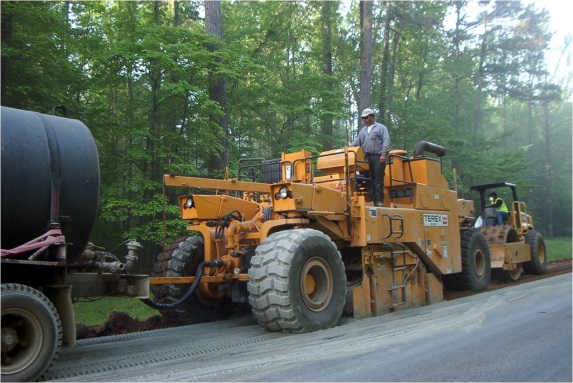 base course. Different types of additives, such as foamed asphalt, asphalt emulsions and chemical agents such as calcium chloride, Portland cement, fly ash and lime, are added to obtain an improved base. Steps in this process are pulverization, introduction of additive, shaping of the mixed material, compaction, and application of a surface or a wearing course. The wearing course may be HMA/WMA, surface treatment (chip seal) or slurry seal depending on the type of road and desired final riding surface. If the in-place material is not sufficient to provide the desired depth of the treated base, new materials may be imported and included in the processing. This method of recycling is normally performed to a depth of 4 to 12 inches.
base course. Different types of additives, such as foamed asphalt, asphalt emulsions and chemical agents such as calcium chloride, Portland cement, fly ash and lime, are added to obtain an improved base. Steps in this process are pulverization, introduction of additive, shaping of the mixed material, compaction, and application of a surface or a wearing course. The wearing course may be HMA/WMA, surface treatment (chip seal) or slurry seal depending on the type of road and desired final riding surface. If the in-place material is not sufficient to provide the desired depth of the treated base, new materials may be imported and included in the processing. This method of recycling is normally performed to a depth of 4 to 12 inches.
In the past few years, VDOT has performed several CIR and one major CCPR project in Virginia. The CIR projects were performed on various primary routes – US 60, SR 35 and US 17. In addition, CIR was performed on I-81 in the Staunton area. On this same project, VDOT performed its first CCPR project. The right-hand lane of I-81 was removed and asphalt base mix from the CCPR process was paved.
In 2012, VDOT installed three test sections at the National Center for Asphalt Technology in Auburn, Alabama. The purpose of this research was to determine the structural performance of the CCPR base material and the overall pavement structure. The test sections will be subjected to 10 years of truck traffic in a period of 2 years or less.
VAA, VDOT, and Virginia asphalt contractors 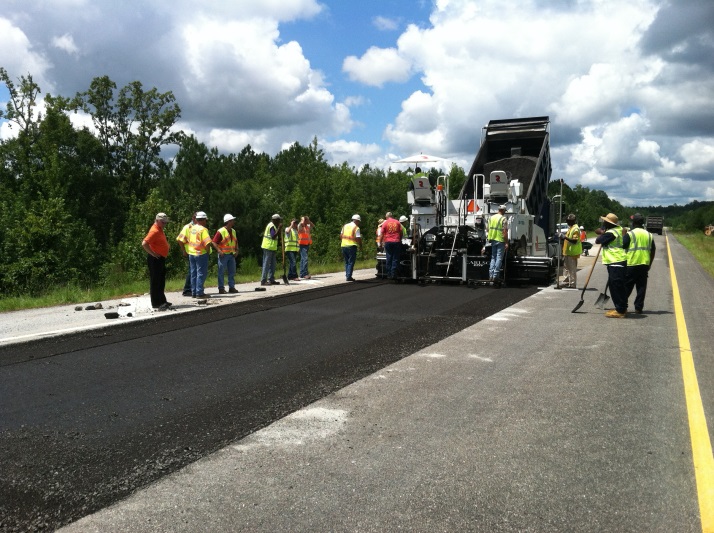 are working together to develop guidelines and improve materials and construction specifications regarding the CIR and CCPR processes. Like any process, it must be used at the right place and at the right time to be cost-effective. Where used, it will not only reduce the initial and long-term cost of the pavement but has significant environmental impacts through the reduced demand on new asphalt binders, new aggregates, and reduction in landfilled materials.
are working together to develop guidelines and improve materials and construction specifications regarding the CIR and CCPR processes. Like any process, it must be used at the right place and at the right time to be cost-effective. Where used, it will not only reduce the initial and long-term cost of the pavement but has significant environmental impacts through the reduced demand on new asphalt binders, new aggregates, and reduction in landfilled materials.

